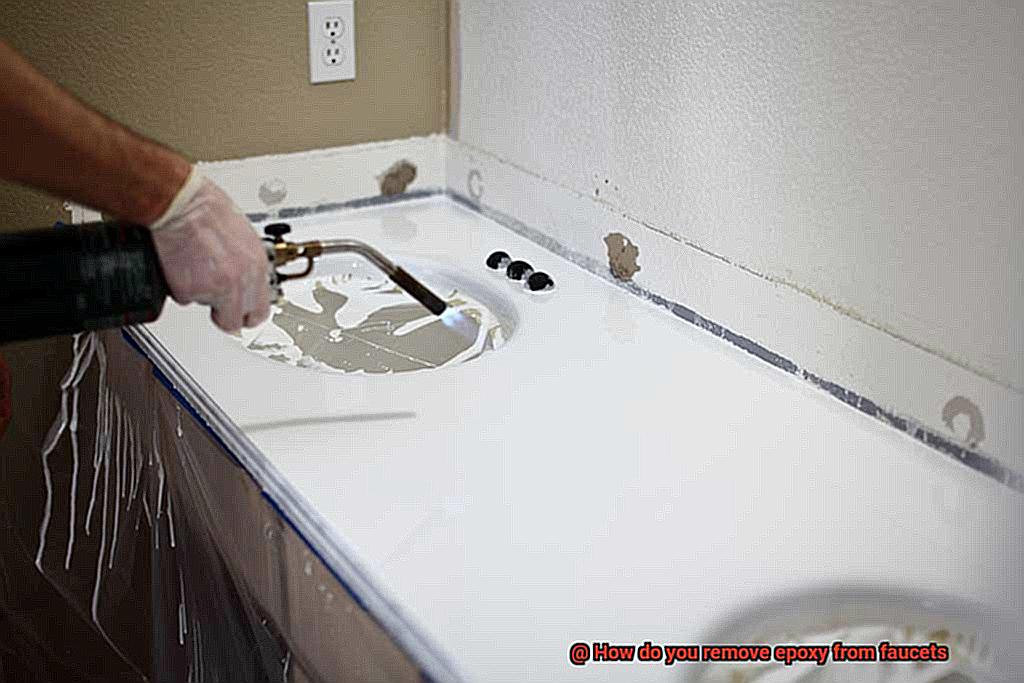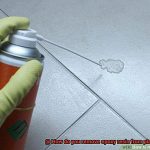Have you ever found yourself in a sticky situation after applying epoxy on your faucet to fix a crack or leak? It’s frustrating when the epoxy hardens and leaves a gooey mess all over your once-pristine faucet. But don’t fret. We’ve got some tips and tricks up our sleeves to help you remove that pesky epoxy.
Epoxy is a powerful adhesive used to bond metals, ceramics, and plastics. Unfortunately, it can be tricky to remove from unintended areas. Thankfully, removing epoxy from faucets is possible with the right tools and techniques.
In this blog post, we’ll guide you through the process of removing epoxy from faucets step-by-step. We’ll share incredible tips and hacks that are sure to get your faucet back to its original glory without damaging the finish.
We’ll cover all the methods that have proven effective in removing epoxy from faucets, including using heat guns and chemical solvents. Whether your faucet has a chrome, nickel, or brass finish, we’ve got you covered with the best methods for each type of material.
So buckle up and get ready to learn how to remove epoxy from faucets like a pro.
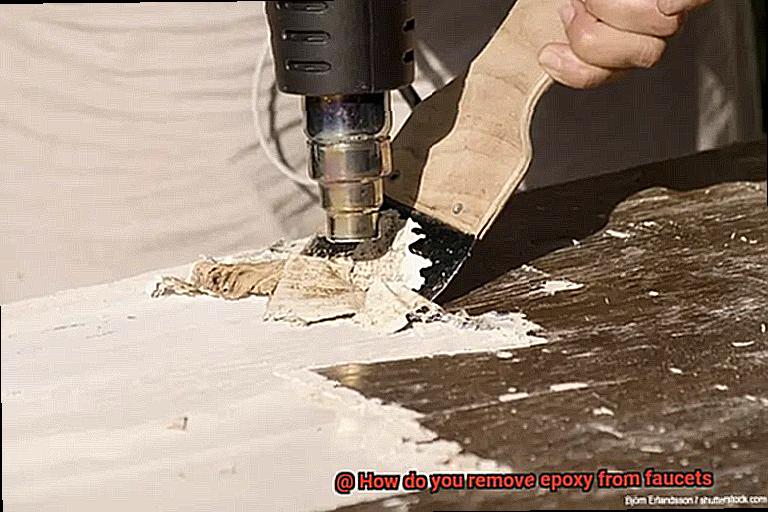
What is Epoxy?
Contents
- 1 What is Epoxy?
- 2 What are the Benefits of Using Epoxy?
- 3 What Are the Challenges of Removing Epoxy from Faucets?
- 4 How to Remove Epoxy from Faucets with a Heat Gun or Hairdryer
- 5 How to Remove Epoxy from Faucets with Acetone
- 6 Alternatives to Acetone for Removing Epoxy from Faucets
- 7 Combining Methods for Effective Results
- 8 Tips and Precautions for Safely Removing Epoxy
- 9 Conclusion
Epoxy is a versatile adhesive that has become a staple material in various industries, ranging from construction to aerospace. This powerful adhesive is known for its exceptional bonding properties, which allow it to withstand extreme temperatures, moisture, and chemicals. The word “epoxy” has roots in the Greek language, with “epi” meaning “on” and “oxy” meaning “sharp” or “acidic.”
The key components of epoxy are resin and hardener. When these two components are mixed together, they undergo a chemical reaction that results in a solid and robust bond. Two-part epoxy is the most common type, which requires mixing both components before application. One-part epoxy is pre-mixed and ready to use, while UV-cured epoxy hardens when exposed to UV light.
Epoxy can be used for various applications, including sealing cracks, bonding metals, and coating floors. Its unique properties make it an ideal adhesive for industries that require strong bonding capabilities.
However, removing epoxy once it has cured can be challenging. If you accidentally get epoxy on your faucets or other surfaces, there are several effective methods that you can use to remove it without damaging the underlying material.
One popular method for removing epoxy from faucets is by using a heat gun or hairdryer. Applying heat softens the epoxy, making it easier to remove. Simply heat up the affected area using a heat gun or hairdryer for several minutes until the epoxy becomes soft and pliable. Then use a plastic scraper or credit card to gently scrape off the epoxy from the faucet.
Another effective method is by using acetone. Acetone is a strong solvent that breaks down the epoxy, making it easier to remove. To use this method, apply a small amount of acetone onto a cotton ball or cloth and rub it onto the affected area. Allow the acetone to sit on the epoxy for several minutes before wiping it off with a clean cloth.
Rubbing alcohol or vinegar can also be used as an alternative to acetone. Both of these substances have acidic properties that can help dissolve the epoxy. Simply apply a small amount of rubbing alcohol or vinegar onto a cotton ball or cloth and rub it onto the affected area. Allow it to sit for several minutes before wiping it off with a clean cloth.
What are the Benefits of Using Epoxy?
Look no further than epoxy. As an expert on the benefits of using epoxy, I can tell you that it offers a plethora of advantages that make it a top choice for bonding and repairing various surfaces.
First and foremost, epoxy is renowned for its ability to create a strong and durable bond between two surfaces. Made up of two parts – resin and hardener – when mixed together, they create a chemical reaction resulting in a permanent bond. This means that you can trust epoxy to repair broken objects or create new ones that need to withstand heavy usage.
What’s more, epoxy is resistant to water and chemicals, making it an ideal choice for areas exposed to moisture or corrosive substances. With epoxy, you won’t have to worry about faucets breaking down due to exposure to water over time.
In addition, epoxy is versatile and easy to use. It can be applied to almost any surface and molded into different shapes. Once it has cured, it can also be sanded, drilled, or painted as needed. This versatility makes it an excellent choice for DIY projects or repairs.
Last but not least, epoxy is affordable and easily accessible at most hardware stores or online. You won’t have to break the bank to get your hands on this powerful adhesive.
What Are the Challenges of Removing Epoxy from Faucets?
Removing epoxy from faucets can be a daunting task, as this strong adhesive is designed to bond surfaces permanently. However, when it comes to removing epoxy from faucets, there are several challenges that one may encounter.
One of the biggest challenges is accessibility. Faucets have intricate designs with small crevices and hard-to-reach areas where epoxy can hide. This makes it difficult to access all the affected surfaces and remove epoxy completely. The presence of water and moisture can also make it more challenging to remove the epoxy, as it can cause the adhesive to become even more resilient.
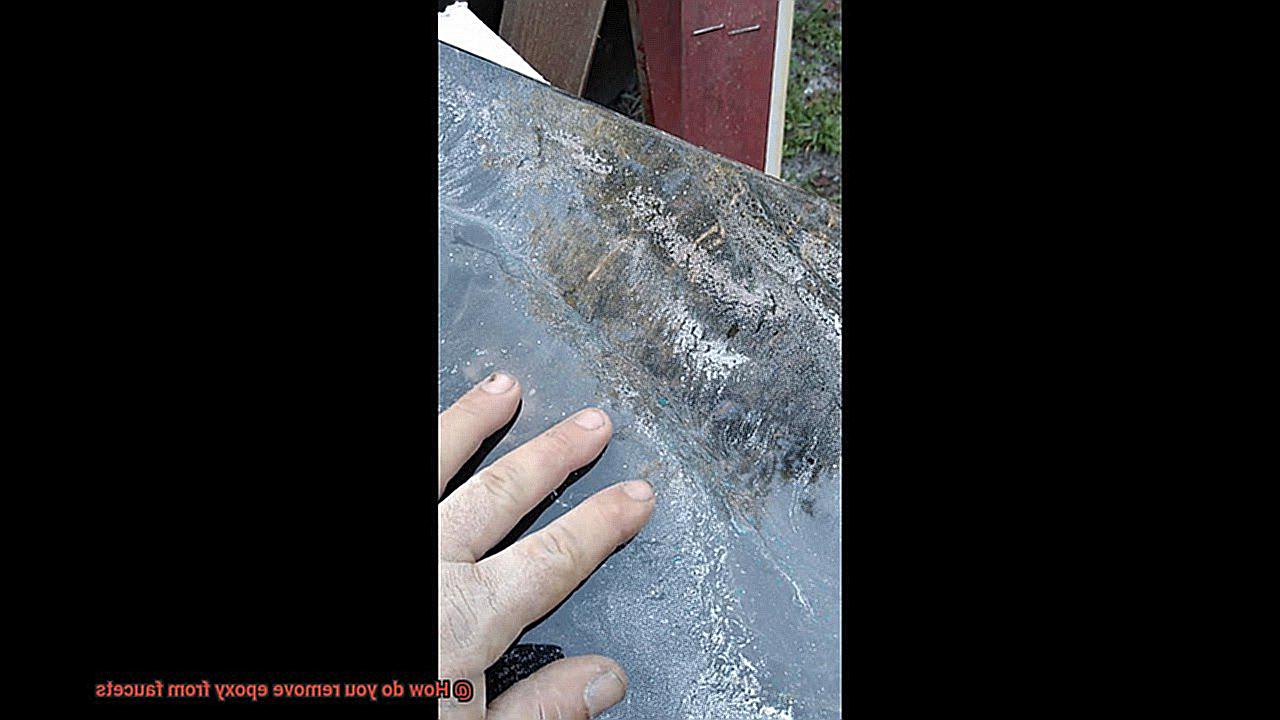
Another challenge is patience. Removing epoxy from faucets is not a quick process. The severity of the bond determines how many attempts it takes to remove all traces of epoxy from the surface of the faucet. This requires a significant amount of time and effort, and it can be tempting to rush through the process. However, taking your time will help ensure that you don’t damage the faucet in the process.
Safety is another crucial factor when removing epoxy from faucets. It’s essential to take appropriate precautions, such as wearing gloves and eye protection and using proper tools and techniques. If too much force is applied or harsh chemicals are used, it can result in damage to the faucet’s surface or even injury.
Finally, there are various methods for removing epoxy from faucets, including heating the affected area or using solvents or abrasives. Each method has its pros and cons, but it’s essential to choose the right approach based on your faucet’s material and the severity of the bond.
How to Remove Epoxy from Faucets with a Heat Gun or Hairdryer
Removing epoxy from faucets can be a pain, but using a heat gun or hairdryer can make the task much easier. However, it’s important to take the necessary safety precautions when using these tools to avoid injury or damage to the faucet.
Gather Your Tools
Before starting, gather the tools you’ll need: a heat gun or hairdryer, a scraper or putty knife, and protective gloves and eyewear. It’s also a good idea to have rubbing alcohol or acetone on hand for cleaning the surface after removing the epoxy.
Heat Up the Epoxy
Hold the heat gun or hairdryer about 2-3 inches away from the epoxy and move it back and forth in a sweeping motion. Be careful not to hold it in one spot for too long, as this can cause damage to the faucet. The heat softens the epoxy, making it easier to remove.
Scrape Off the Epoxy
Once the epoxy has softened, use a plastic scraper or putty knife to gently scrape off as much of it as possible. Avoid using metal tools that could scratch or damage the surface of the faucet.
Clean the Surface
Use rubbing alcohol or acetone to clean the surface and remove any remaining residue. Be sure to follow any safety instructions on the label of your cleaning product, and wear protective gloves and eyewear.
Repeat if Necessary
If there are still traces of epoxy left on the faucet, repeat the heating and scraping process until all of it has been removed.
Overall, using a heat gun or hairdryer can be an effective method for removing epoxy from metal faucets. However, make sure to take proper safety precautions and be patient during the process. Also, note that this method should not be used on plastic faucets as they can melt under high heat.
How to Remove Epoxy from Faucets with Acetone
Look no further than acetone, a powerful solvent that can dissolve epoxy without damaging the surface of your faucet. But before you begin, take note of the following steps to ensure a safe and effective process.
Step 1: Gather Materials and Take Precautions
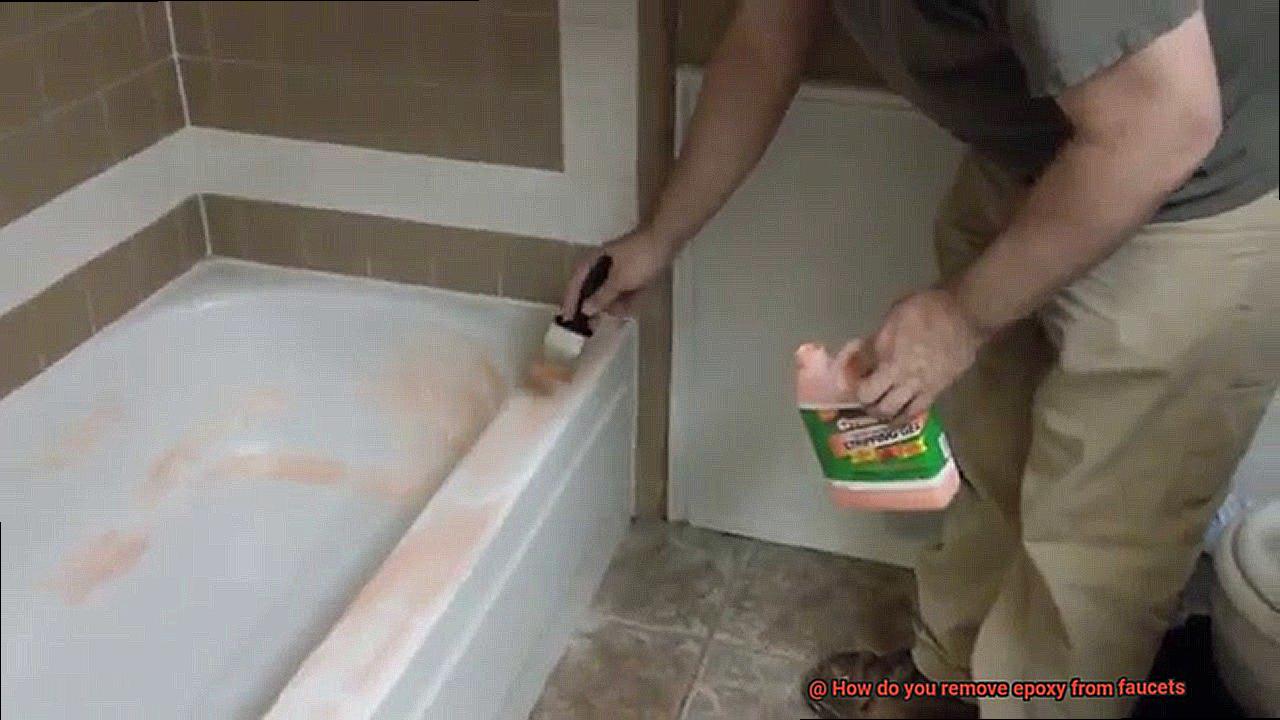
Step 2: Apply Acetone
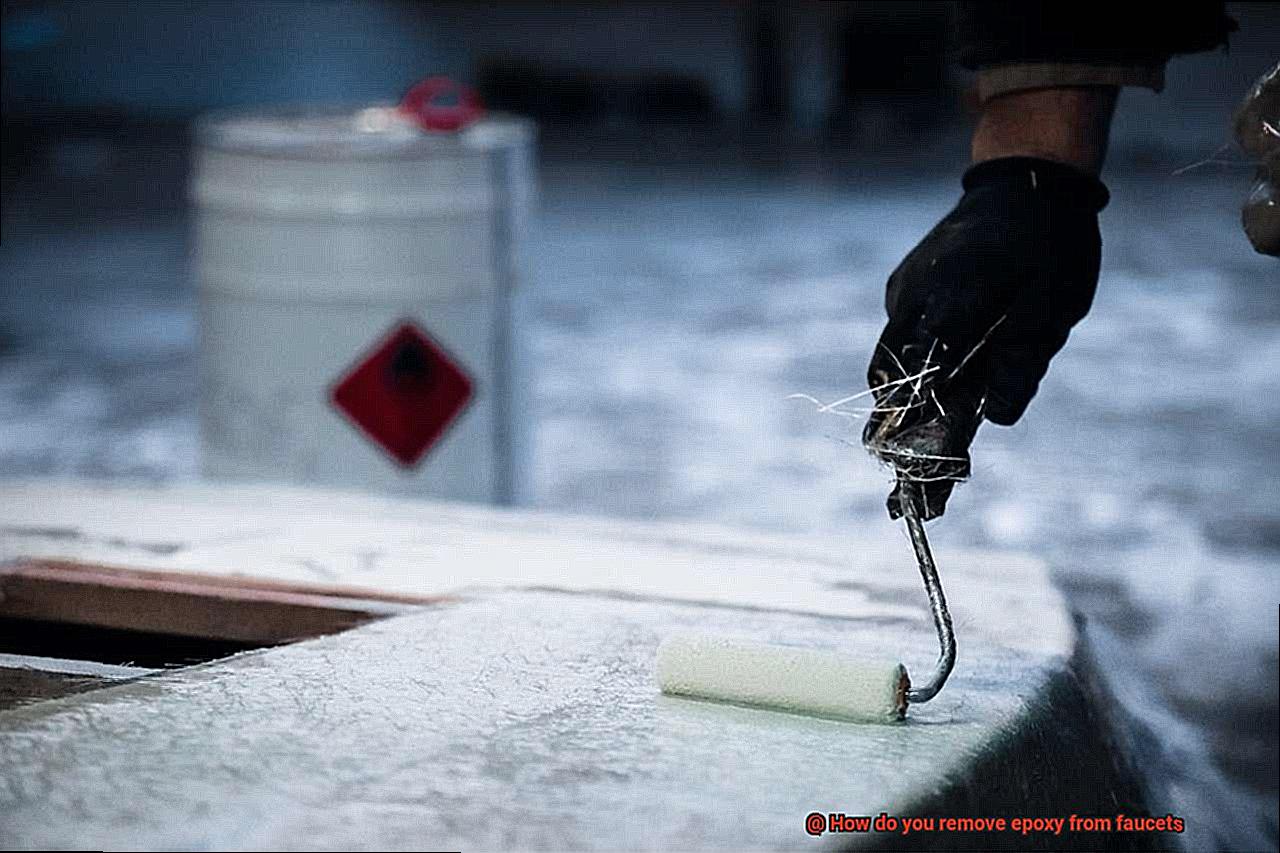
Using a clean cloth, apply a small amount of acetone onto the affected area of the faucet. Avoid using too much acetone as it can cause damage to other parts of the faucet or surrounding surfaces. Allow the acetone to sit on the epoxy for a few minutes to dissolve it.
Step 3: Gently Scrape Away Epoxy
Once the epoxy has softened, use a plastic scraper or toothbrush to gently scrape away the softened epoxy. Be patient and avoid using excessive force as this could damage your faucet.
Step 4: Repeat as Needed
If the epoxy is particularly stubborn, you may need to repeat this process several times. Remember to be gentle and do not use excessive force as this could damage your faucet.
Step 5: Rinse and Dry Faucet
Once all of the epoxy has been removed, thoroughly rinse the faucet with water and dry it with a clean cloth. Make sure to properly dispose of any rags or cotton balls soaked in acetone as they are flammable and can pose a fire hazard if not disposed of correctly.
It’s important to note that acetone should not be used on certain types of faucets, such as those made of plastic or painted surfaces, as it can cause damage. In these cases, it’s best to consult with a professional or manufacturer for alternative solutions.
Alternatives to Acetone for Removing Epoxy from Faucets
Luckily, there are several alternatives you can try that are just as effective and likely already in your home.
First on the list is vinegar. This common household item is a powerful cleaning agent and can easily remove epoxy from faucets. Simply soak a cloth or sponge in vinegar and apply it to the affected area. Let it sit for several minutes before wiping it away with a clean cloth. The acidic properties of the vinegar work to dissolve the epoxy, leaving your faucet looking shiny and new.
Another option is baking soda and hot water. Mix equal parts baking soda and hot water to create a paste. Apply the paste to the affected area and let it sit for several minutes before gently scrubbing with a soft-bristled brush. The baking soda acts as an abrasive, gently removing the epoxy without damaging the faucet’s surface. Rinse the area with warm water and dry with a clean cloth.
If you prefer a more traditional approach, rubbing alcohol can also be used as an alternative to acetone. Apply rubbing alcohol to a cloth or cotton ball and gently rub the affected area. The alcohol dissolves the epoxy, making it easier to remove. Repeat this process until all of the epoxy has been removed.
It’s important to keep in mind that while these alternatives may be less harsh than acetone, they may still require some elbow grease and patience to fully remove the epoxy. It’s also crucial to test any method on a small, inconspicuous area of the faucet first to ensure it doesn’t cause any damage or discoloration.
Combining Methods for Effective Results
Say no more. The good news is that removing epoxy from faucets can be a less daunting task when you combine multiple methods to achieve effective results.
One popular method for removing epoxy is heat. Using a heat gun or hair dryer to warm up the epoxy makes it easier to scrape off using a plastic scraper or razor blade. However, for stubborn pieces of epoxy, this method may fall short.
Another effective method is using solvents or chemicals designed for removing epoxy. Such products can be found in hardware stores or online and contain chemicals that break down the adhesive properties of the epoxy. It’s important to read the label carefully and use these products with caution and safety gear.
A third approach is using abrasives like sandpaper or steel wool to physically scrape away the epoxy. However, it’s crucial to take care not to damage the faucet itself when using this method.
The real trick lies in combining these methods for optimal results. You could start by using heat to soften the epoxy, then apply a solvent to break it down further before finishing off with an abrasive tool. By doing so, you create a powerful approach that guarantees sparkling faucets.
Keep in mind that removing epoxy takes time and patience, so avoid rushing the process. Always prioritize safety by wearing protective gear and testing new products on a small area first.
Tips and Precautions for Safely Removing Epoxy
Removing epoxy from faucets can be a daunting task, especially if you want to avoid damaging the fixture. Fortunately, there are several tips and precautions that you can take to safely remove epoxy from your faucets.
Protect Yourself
Epoxy removers are harsh chemicals that can irritate your skin and eyes. Always wear protective gear such as gloves, goggles, and a respirator mask to avoid any skin or eye irritation.
Work in a Well-Ventilated Area
It is essential to work in a well-ventilated area while removing epoxy from faucets. The fumes from the epoxy remover can be harmful if inhaled for prolonged periods.
Read Instructions Carefully
Always read the instructions carefully on the epoxy remover product before using it. It will provide you with information on how to apply it correctly and what safety measures to take.
Test a Small Area First
Before applying the epoxy remover to the entire faucet, test a small area first to make sure that it does not damage the surface of the faucet.
Use a Heat Gun
One of the most effective ways to remove epoxy from faucets is by using a heat gun. The heat will soften the epoxy, making it easier to scrape off with a plastic scraper or putty knife. Be careful not to overheat the faucet and damage the surface.
Use Solvents
If a heat gun isn’t an option, solvents like acetone or rubbing alcohol can also help to dissolve the epoxy. Be sure to test the solvent on a small, inconspicuous area first to make sure it won’t damage the faucet.
Be Gentle
When scraping off epoxy, use a plastic scraper or putty knife instead of metal tools that could scratch the surface of the faucet. Be patient and work slowly to avoid damaging the faucet.
Clean Thoroughly
Once all of the epoxy has been removed, clean the faucet thoroughly with a mild soap and water solution. Rinse well and dry with a clean cloth.
Conclusion
Removing epoxy from faucets can be a daunting task, but fear not, it’s entirely doable. Armed with the right tools and techniques, you can remove stubborn epoxy without damaging your faucet’s finish. We’ve covered several effective methods in this blog post, including using heat guns, solvents like acetone or rubbing alcohol, and abrasives such as sandpaper or steel wool.
Safety should always come first when attempting to remove epoxy from faucets. Ensure that you’re wearing protective gloves and eye gear while working in a well-ventilated area. Additionally, read the instructions carefully before using any chemicals.
For particularly stubborn pieces of epoxy, combining different methods can yield optimal results. However, it’s vital to take your time and exercise patience during the process to avoid damaging the faucet.
In conclusion, removing epoxy from faucets requires some elbow grease and perseverance.

